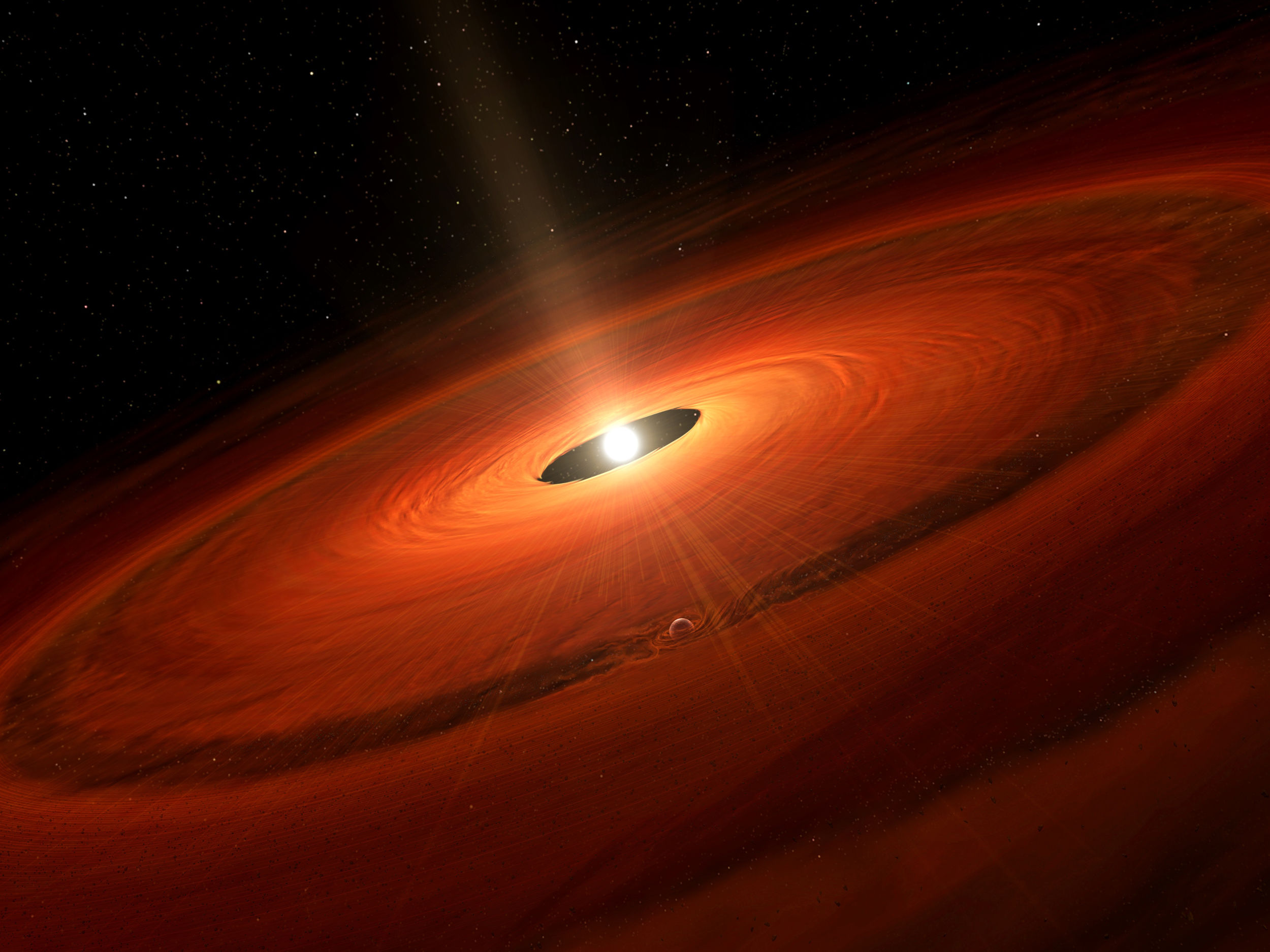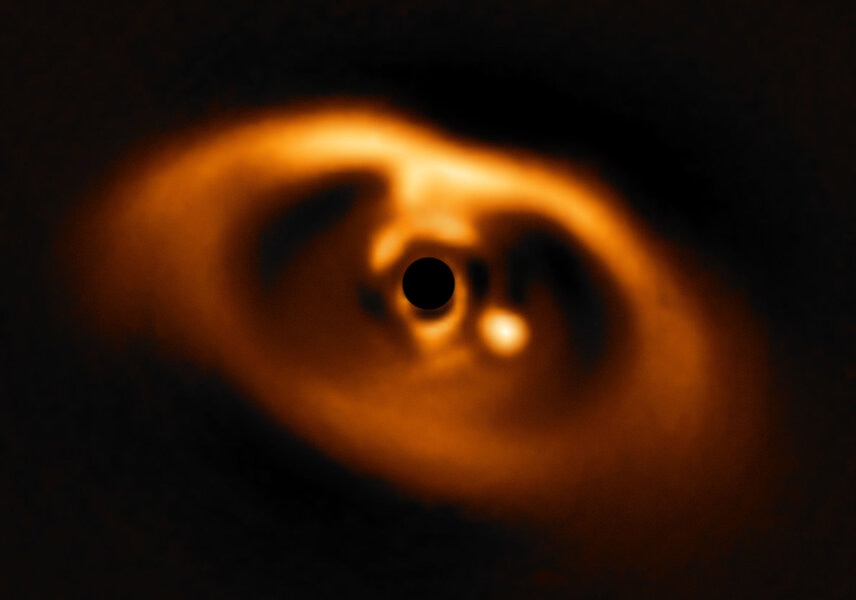Create a free profile to get unlimited access to exclusive videos, sweepstakes, and more!
Astronomical birth announcement: It's a bouncing baby planet!

For the first time, astronomers have seen the birth of a giant planet while it's still occurring! We have seen young planets, and stars before their planets are born, and even while planets are forming, but never before have there been clear observations of the planet itself in flagrante delicto.
To see why this is so cool you need a bit of background.
The star is called PDS 70, and is located about 370 light-years away. It's part of a loose grouping of very young stars called the Scorpius-Centaurus Association, many of which are still in the process of forming, and is the closest such group to us in the galaxy.
The star itself is about 5.4 million years old, so it's very young indeed (the Sun is a middle-aged 4.6 billion years old). Because it's young, its physical characteristics are a little odd. In general, stars the same age but less massive than the Sun are also smaller; however, while PDS 70 has only 0.76 times the Sun's mass, it's fully 1.25 times wider. It's much less luminous, though, shining with only about 1/3rd the energy the Sun emits.
Observations in 2002 showed it is surrounded by a disk of material, again a sign of youth. Stars form from clouds of gas and dust, which collapse due to some outside influence (perhaps two clouds collide, or the wind from a nearby massive star applies pressure to it). As a cloud collapses, random eddies get magnified, and the cloud flattens into a disk. Eventually, when the forming star (called a protostar) "switches on" — nuclear fusion is triggered in this core — it becomes a proper star, and its light and wind blow away the remnants of the disk from which it formed.
But that skips over an important step: planetary formation. While the details of the process are still being worked on (give astronomers a break here: We've only had good data on this stuff for a few years!), essentially small grains of material form from the disk, which grow as they collide and stick with other ones. They grow in size, becoming bigger grains, then pebbles, then rocks, then boulders, then… well, you get the picture. When they get to a few hundred kilometers across we call them protoplanets, and gravity takes over, drawing material in actively. Finally, a planet is born.
Or so we assume. We've seen indirect evidence of this, many times, in disks. For example, some disks have gaps in them, which makes sense if there's a planet in there forming. It carves out the gap as it eats up material in the disk. We've seen other indications of planets as well, but never the forming planet itself (at least, not until well after the formation process was complete).
Until now. The new planet*, called PDS 70b, can be seen directly in images taken using SPHERE, a powerful camera on the Very Large Telescope in Chile. It can measure polarized light, which is light where the wavelengths are all aligned in one way. Light from a star is typically not polarized, but it is when it's reflected of a dusty disk. By adjusting their observations, astronomers can emphasize the material in the faint disk while suppressing the much brighter light from the star. They also observed PDS 70 in infrared light, which helps too. A warm disk emits more IR light, while a star typically emits less. That increases contrast.
In these images, a point source pops right out. Analysis of the source indicates it's likely not some random clump or disk feature (it's not polarized as disk material would be), but is instead a massive substellar object: a planet. Given the age of the star (and the assumption that the planet is younger than the star), this planet is still in the process of formation!
There's more evidence of that. For example, the planet is very red, which only makes sense if there's still a lot of warm material around it. That material would be the stuff from the disk it’s still actively drawing in.
The planet is about 3.3 billion kilometers out from the star, about 22 times farther than the Earth is from the Sun, roughly the distance of Uranus from the Sun. You'd think it would be cold, but actually it's quite hot! Remember, it's still forming, pulling in huge amounts of matter from the disk. That stuff hits the planet and heats it up (think of it like trillions of teeny meteorite impacts), so it's actually somewhere between roughly 750 and 1350° C. That's why it's seen in the infrared; objects at that temperature glow strongly in IR.
The size of the planet is between 1.4 – 3.4 times that of Jupiter (a size toward the lower end is more likely) and has a mass between five and 12 times Jupiter's. The range is large because it's difficult to determine these characteristics. Astronomers measure the colors of the planet using different filters, then compare the colors you'd expect using physical models of what planets should look like given different parameters (mass, age temperature, and so on). Only a few colors have been measured for PDS 70b, not enough to cleanly separate the model predictions.
However, one thing they found is that a purely thermal model of the planet doesn't fit the data. In other words, a hot lump of stuff sitting there wouldn't produce the colors they see; you have to add clouds of material in the planet's atmosphere to match the observations! It's not clear what those clouds would be made of — there's an intriguing feature that implies the presence of water, but it's pretty iffy — but they do seem to exist.
Incredible. This planet is 3.7 quadrillion kilometers away and glowing hot, yet we can tell it's having a partly cloudy day.
I love astronomy.
There's another point I found fascinating. The disk around the star extends a long way, over 15 billion kilometers (that’s well past Neptune's distance from the Sun). There's data supporting that there's an inner disk extending from the star out to about 2.5 billion kilometers, but a big gap from there out to over eight billion kilometers, ostensibly carved by the planet. But the planet is on the inner edge of that disk, not in the middle as you might expect. I suspect that's because the planet is migrating inward, toward the star. As it draws in material from the disk the overall effect is the planet loses orbital energy through drag, so it drops toward the star.
This was a process that we didn't really know occurred until recently. The first planets discovered were big Jupiter-sized gas giants very close to their stars (called "hot Jupiters" for that reason). It's pretty clear they can't form that close in, so they must have formed farther out and moved inward. We think the gas giants in our solar system migrated around in the early days, too. And here we see PDS 70b on the inner edge of its disk, too. Hmmmm.
All of this is amazing. We didn't know of any planets besides ours until 1992, and now we've confirmed the existence of nearly 4,000 exoplanets. The first disks around other stars were detected in the 1980s, and we didn't start getting clear images of them until the 1990s. We started seeing structures in them, implying planets… and now here we are. An image of a newborn baby planet! Hot and gassy and still growing, and unclear what its future holds, but then, it's a baby.
Did I mention that I love astronomy? The fact that we can do these things, that we can even think of doing these things, will never cease to stun me. And all because scientists want to know things.
*Heh. In general, when I write about a new planet, I mean new to us. In this case, it really is new.















